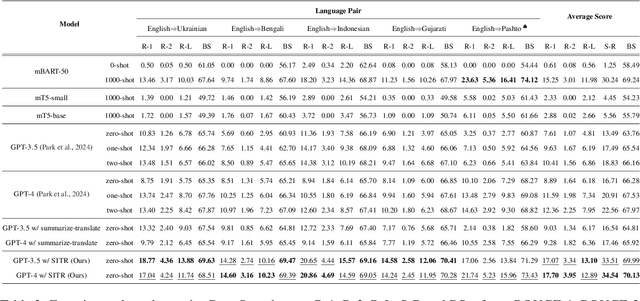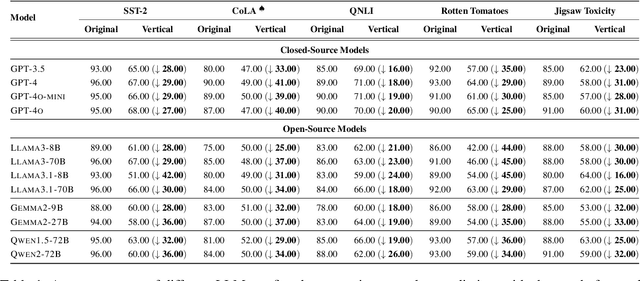Zhecheng Li
$A^2R^2$: Advancing Img2LaTeX Conversion via Visual Reasoning with Attention-Guided Refinement
Jul 28, 2025Abstract:Img2LaTeX is a practically significant task that involves converting mathematical expressions or tabular data from images into LaTeX code. In recent years, vision-language models (VLMs) have demonstrated strong performance across a variety of visual understanding tasks, owing to their generalization capabilities. While some studies have explored the use of VLMs for the Img2LaTeX task, their performance often falls short of expectations. Empirically, VLMs sometimes struggle with fine-grained visual elements, leading to inaccurate LaTeX predictions. To address this challenge, we propose $A^2R^2$: Advancing Img2LaTeX Conversion via Visual Reasoning with Attention-Guided Refinement, a framework that effectively integrates attention localization and iterative refinement within a visual reasoning framework, enabling VLMs to perform self-correction and progressively improve prediction quality. For effective evaluation, we introduce a new dataset, Img2LaTex-Hard-1K, consisting of 1,100 carefully curated and challenging examples designed to rigorously evaluate the capabilities of VLMs within this task domain. Extensive experimental results demonstrate that: (1) $A^2R^2$ significantly improves model performance across six evaluation metrics spanning both textual and visual levels, consistently outperforming other baseline methods; (2) Increasing the number of inference rounds yields notable performance gains, underscoring the potential of $A^2R^2$ in test-time scaling scenarios; (3) Ablation studies and human evaluations validate the practical effectiveness of our approach, as well as the strong synergy among its core components during inference.
Mapping the Minds of LLMs: A Graph-Based Analysis of Reasoning LLM
May 20, 2025Abstract:Recent advances in test-time scaling have enabled Large Language Models (LLMs) to display sophisticated reasoning abilities via extended Chain-of-Thought (CoT) generation. Despite their potential, these Reasoning LLMs (RLMs) often demonstrate counterintuitive and unstable behaviors, such as performance degradation under few-shot prompting, that challenge our current understanding of RLMs. In this work, we introduce a unified graph-based analytical framework for better modeling the reasoning processes of RLMs. Our method first clusters long, verbose CoT outputs into semantically coherent reasoning steps, then constructs directed reasoning graphs to capture contextual and logical dependencies among these steps. Through comprehensive analysis across models and prompting regimes, we reveal that structural properties, such as exploration density, branching, and convergence ratios, strongly correlate with reasoning accuracy. Our findings demonstrate how prompting strategies substantially reshape the internal reasoning structure of RLMs, directly affecting task outcomes. The proposed framework not only enables quantitative evaluation of reasoning quality beyond conventional metrics but also provides practical insights for prompt engineering and the cognitive analysis of LLMs. Code and resources will be released to facilitate future research in this direction.
Texture or Semantics? Vision-Language Models Get Lost in Font Recognition
Mar 31, 2025Abstract:Modern Vision-Language Models (VLMs) exhibit remarkable visual and linguistic capabilities, achieving impressive performance in various tasks such as image recognition and object localization. However, their effectiveness in fine-grained tasks remains an open question. In everyday scenarios, individuals encountering design materials, such as magazines, typography tutorials, research papers, or branding content, may wish to identify aesthetically pleasing fonts used in the text. Given their multimodal capabilities and free accessibility, many VLMs are often considered potential tools for font recognition. This raises a fundamental question: Do VLMs truly possess the capability to recognize fonts? To investigate this, we introduce the Font Recognition Benchmark (FRB), a compact and well-structured dataset comprising 15 commonly used fonts. FRB includes two versions: (i) an easy version, where 10 sentences are rendered in different fonts, and (ii) a hard version, where each text sample consists of the names of the 15 fonts themselves, introducing a stroop effect that challenges model perception. Through extensive evaluation of various VLMs on font recognition tasks, we arrive at the following key findings: (i) Current VLMs exhibit limited font recognition capabilities, with many state-of-the-art models failing to achieve satisfactory performance. (ii) Few-shot learning and Chain-of-Thought (CoT) prompting provide minimal benefits in improving font recognition accuracy across different VLMs. (iii) Attention analysis sheds light on the inherent limitations of VLMs in capturing semantic features.
Enhancing LLM Character-Level Manipulation via Divide and Conquer
Feb 12, 2025



Abstract:Large Language Models (LLMs) have demonstrated strong generalization capabilities across a wide range of natural language processing (NLP) tasks. However, they exhibit notable weaknesses in character-level string manipulation, struggling with fundamental operations such as character deletion, insertion, and substitution. These challenges stem primarily from tokenization constraints, despite the critical role of such operations in data preprocessing and code generation. Through systematic analysis, we derive two key insights: (1) LLMs face significant difficulties in leveraging intrinsic token knowledge for character-level reasoning, and (2) atomized word structures can substantially enhance LLMs' ability to process token-level structural information. Building on these insights, we propose Character-Level Manipulation via Divide and Conquer, a novel approach designed to bridge the gap between token-level processing and character-level manipulation. Our method decomposes complex operations into explicit character-level subtasks coupled with controlled token reconstruction phases, leading to significant improvements in accuracy. Without additional training, our method significantly improves accuracies on the $\texttt{Deletion}$, $\texttt{Insertion}$, and $\texttt{Substitution}$ tasks. To support further research, we open-source our implementation and benchmarks.
DRS: Deep Question Reformulation With Structured Output
Nov 27, 2024



Abstract:Question answering is a fundamental capability of large language models (LLMs). However, when people encounter completely new knowledge texts, they often ask questions that the text cannot answer due to a lack of understanding of the knowledge. Recent research shows that large language models identify the unanswerability of questions, but they lack the ability to help people reformulate their questions. Even powerful models like GPT-3.5 perform poorly in this regard. To enhance the ability of LLMs to assist humans in reformulating questions to extract relevant knowledge from new documents, we propose a zero-shot method called DRS: Deep Question Reformulation With Structured Output. Our proposed method leverages large language models and the DFS-based algorithm to iteratively search for possible entity combinations and constrain the output with certain entities, effectively improving the capabilities of large language models in this area. Extensive experimental results show that our zero-shot DRS method significantly improves the reformulation accuracy of GPT-3.5 from 23.03% to 70.42% and effectively improves the score of open-source large language models, such as Gemma2-9B, from 26.35% to 56.75%.
Think Carefully and Check Again! Meta-Generation Unlocking LLMs for Low-Resource Cross-Lingual Summarization
Oct 26, 2024



Abstract:Cross-lingual summarization (CLS) aims to generate a summary for the source text in a different target language. Currently, instruction-tuned large language models (LLMs) excel at various English tasks. However, unlike languages such as English, Chinese or Spanish, for those relatively low-resource languages with limited usage or data, recent studies have shown that LLMs' performance on CLS tasks remains unsatisfactory even with few-shot settings. This raises the question: Are LLMs capable of handling cross-lingual summarization tasks for low-resource languages? To resolve this question, we fully explore the potential of large language models on cross-lingual summarization task for low-resource languages through our four-step zero-shot method: Summarization, Improvement, Translation and Refinement (SITR) with correspondingly designed prompts. We test our proposed method with multiple LLMs on two well-known cross-lingual summarization datasets with various low-resource target languages. The results show that: i) GPT-3.5 and GPT-4 significantly and consistently outperform other baselines when using our zero-shot SITR methods. ii) By employing our proposed method, we unlock the potential of LLMs, enabling them to effectively handle cross-lingual summarization tasks for relatively low-resource languages.
Vulnerability of LLMs to Vertically Aligned Text Manipulations
Oct 26, 2024



Abstract:Text classification involves categorizing a given text, such as determining its sentiment or identifying harmful content. With the advancement of large language models (LLMs), these models have become highly effective at performing text classification tasks. However, they still show vulnerabilities to variations in text formatting. Recent research demonstrates that modifying input formats, such as vertically aligning words for encoder-based models, can substantially lower accuracy in text classification tasks. While easily understood by humans, these inputs can significantly mislead models, posing a potential risk of bypassing detection in real-world scenarios involving harmful or sensitive information. With the expanding application of LLMs, a crucial question arises: Do decoder-based LLMs exhibit similar vulnerabilities to vertically formatted text input? In this paper, we investigate the impact of vertical text input on the performance of various LLMs across multiple text classification datasets and analyze the underlying causes. Our findings are as follows: (i) Vertical text input significantly degrades the accuracy of LLMs in text classification tasks. (ii) Chain of Thought (CoT) reasoning does not help LLMs recognize vertical input or mitigate its vulnerability, but few-shot learning with careful analysis does. (iii) We explore the underlying cause of the vulnerability by analyzing the inherent issues in tokenization and attention matrices.
 Add to Chrome
Add to Chrome Add to Firefox
Add to Firefox Add to Edge
Add to Edge